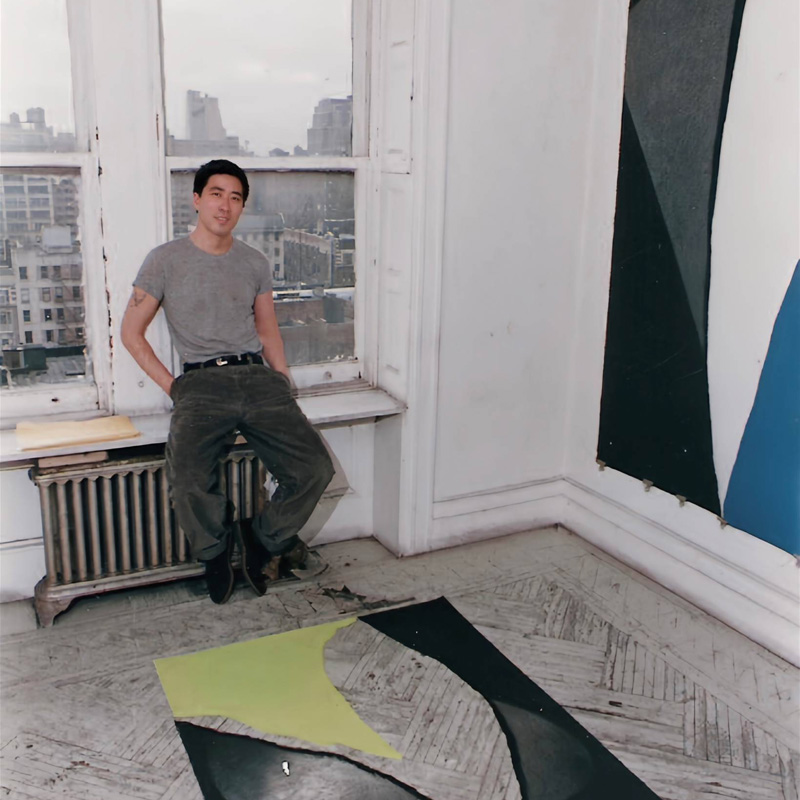郑庆和于1946年出生于古巴,并在六十年代至八十年代的纽约市中心文化中长大,在这段时光里,他创作了大量精彩的作品。由于艾滋病的加重,他的艺术生命在1989年结束了。 郑庆和的职业生涯既是短暂也是绚烂的,在世期间他曾被众多画廊和博物馆展览过。如今他被认为是那一代最重要的亚裔美国艺术家之一。他主要在纸上用水粉、墨水、石墨和混合媒介进行创作,他的作品中充满穿透力的精神力量,和他自身耀眼的生命一同为世人带来源源不断的能量。 郑庆和出生在古巴的一个外交官家庭,他的家人很快搬到了美国,此后庆和就在纽约皇后区长大。他夏天在艺术学生联盟学习,接着考入库珀联盟艺术学院。他的大学时代充满了越南战争和征兵的硝烟,在这期间,庆和从道教中寻找到了慰藉。道教为他打开了一扇通往更加形而上思想之路的门,使他思考存在,并逐渐在他的生活中占绝对的主导地位。神秘的东方思想成为一个隐喻,永恒地穿梭在他整个艺术生涯中。 在二十世纪六十年代轰轰烈烈的「反主流文化运动」时,庆和居住在East VIllage,并在七十年代搬往了Soho,最终他在事业全盛时期住进了著名的切尔西酒店,酒店经理斯坦利·巴德会根据庆和的作品大小的变化来为他租下不同的公寓。在那段日子里,市中心是纽约的创意圣地,郑庆和是在著名的麦克斯堪萨斯城酒吧和切尔西酒店之中驻扎的艺术家中不可或缺的一员,这些人里包括威廉·博洛夫斯(William Boroughs)、安迪·沃霍尔(Andy Warhol)、罗伯特·梅普尔索普(Robert Mapplethorpe)、拉里·里弗斯、艾伦·金斯堡(Allen Ginsburg) 以及塔利·布朗(Tally Brown). 郑庆和的作品主要分为四个不同的时期。迷幻、水粉、撕毁和炼金作品。尽管在绘画风格上它们看起来迥然不同,但在其中有一种共生的关系连接着四个时期的创作:六十年代末从库珀联盟艺术学院毕业后,他开始使用水粉和墨水作为媒介创作动态迷幻系列;从西藏艺术中的精神象征主义以及当时流行的对潜意识的其他探索中,这些错综复杂的超现实主义交融进他的心灵。庆和获得了很大的启发,他以佛法为主导参照物,开始探索心灵和精神的幻想领域。 在此之后的下一个系列,即十九世纪七十年代中后期,庆和没有再绘画“爆炸"作品。他说,在水粉作品中,描绘的日常物品被赋予了形而上的属性,他希望观众在观看这些物品时能有所体验。庆和的画作总以非常精确的方式呈现,并经常使用符号学,使观众能够透过主体看到它们之外的天体空间。 十九世纪八十年代初创作的"撕毁作品 "是出于将不符合自己高标准的作品撕毁的习惯,创作于艾滋病流行期间,当时他的许多朋友都不幸去世了。这是一组非常大胆的探索性作品,象征性的颜色是这些作品的内在要素,其中用石墨渲染的重现的石碑,灵感部分来自库布里克1968年的电影《2001年:太空漫游》,部分来自清和对道教的坚定兴趣。 郑庆和的炼金术作品则是在八十年代末通过在纸上涂抹氧化铁和石膏而创作的。这些几乎是雕塑般的作品是为了模仿他在访问土耳其时看见的石窟的朴素感。画作经过自然处理,通过将纸张浸泡在酒店允许他在房间里建造的人造水池中,产生铁锈和纹理。撕裂的铁锈碎片经过了几周的腌制,并最终变成三维的“颜料”。《石窟》,这是一件10英尺高、横跨25英尺长的巨大圆弧,也是郑庆和被艾滋病夺去生命前的最后一件杰作。正如庆和所说,"这些画是对 "奇迹 "的暗示。其意义是由欣赏者来发现的...... 郑庆和一生中大量作品都被著名画廊、博物馆收藏和展出,如Hirschhorn博物馆和雕塑馆、惠特尼美国艺术博物馆、史密森尼美国艺术博物馆、克利夫兰艺术博物馆、底特律艺术博物馆、菲利普斯收藏馆、布鲁克林博物馆和纽约大学的Grey艺术画廊,该画廊在1987年展出了《石窟》。他去世之后,众多作品被重要机构收藏,包括惠特尼美国艺术博物馆、史密森美国艺术博物馆、底特律艺术博物馆、菲利普斯收藏等等。郑庆和的作品参与了卓纳画廊(David Zwirner)纽约 More Life 系列展览中。 Ching-Ho Cheng’s (b.1946) was born in Cuba and grew up in the throes of the downtown NY scene in the sixties, seventies and eighties. His colorful life was cut short by AIDS in 1989 but not before he compiled a mesmerizing and profound body of work. Having had a significant career during his lifetime- with many gallery and museum shows, he is now being considered as one of the foremost Asian American artists of his generation. Working primarily on paper with gouache, ink, graphite, and mixed mediums Cheng’s penetrating spirituality and flamboyant life offers lessons for us all. Ching Ho Cheng was born in Cuba in 1946 to a family of diplomats. His family soon moved to the United States and Ching grew up in Queens, NY. He spent his summers studying at the Arts Students League before matriculating to the Cooper Union School of Art. His college years were marked by the Vietnam War and its draft. During this time Ching found solace in Taoism which would become predominant in his life and open his mind to the metaphysical. It became a subtle, but significant, presence throughout his entire oeuvre. Ching lived in the East Village during the 1960s counter-culture movement and in Soho during the nineteen-seventies. Eventually, he landed at the famous Chelsea Hotel at the height of its heyday where the manager Stanley Bard would rent Ching different apartments according to the changing size of his work. Downtown was the creative mecca of New York in those days and Ching was integral to the scene which circled between the famed Max’s Kansas City Bar and the Chelsea Hotel, which included luminaries such as William Boroughs, Andy Warhol, Robert Mapplethorpe, Allen Ginsburg, and Tally Brown. Ching Ho Cheng’s work is divided into four distinct periods, the Psychedelics, Gouache, Torn Works, and Alchemical Works. Although they appear to be completely different in painting style, there is a symbiotic relationship that connects all four periods. After graduating from the Cooper Union School of Art in thelate sixties, he began his dynamic psychedelic series using gouache and ink as a medium. He was greatly inspired by the spiritual symbolism in Tibetan art as well as other explorations of the subconscious that were popular during that time. These intricate surrealistic works explore the fantastical realms of the mind and spirit using the dharma as its leading referent. In his next series, which run through the mid to late nineteen-seventies, Ching painted without “explosions” as he put it. In the Gouache Works he depicted everyday objects that were imbued with metaphysical attributes that he hoped the viewer would experience when viewing them. His paintings, rendered with exact precision and often employing symbology, allowed the viewer to see through the subjects to the celestial space beyond them. The Torn Works which were made in the early nineteen-eighties came out of a habit of tearing works that did not meet his high standards. They are strikingly bold and were created during the AIDS epidemic when many of his friends tragically died. Symbolic colors are intrinsic to these works as well as the reappearing monolith rendered in graphite that was inspired in part by Kubrick’s cult film of 1968, 2001: A Space Odyssey and in part by Ching’s unwavering interest in Taoism. Ching’s alchemical works were created in the late nineteen-eighties by applying iron oxide and gesso on paper. These almost sculptural works were meant to mimic the austere grottoes that he experienced on a visit to Turkey. The paintings were naturally processed to generate rust and texture by soaking the paper in a man-made pool that the hotel allowed him to construct in his room. These torn rust pieces marinated over a period of weeks until they became three dimensional. “The Grotto,” a huge arc 10 feet tall that spans a length of 25 feet, would be Ching’s last master work before he died of AIDS in 1989. As Ching said, “these paintings are intimations of the “miraculous”. The meaning is for the beholder to discover… During his lifetime Ching’s work was shown and collected by major institutionssuch as the Hirschhorn Museum & Sculpture Garden, The Cleveland Museum of Art, Brooklyn Museum and NYU’s The Grey Art Gallery which exhibited “The Grotto” in 1987. Posthumously his work has been collected by many other major institutions including The Whitney Museum of American Art, Smithsonian American Art Museum, The Detroit Museum of Art, The Phillips Collection and many others. Most recently a survey of Ching’s work was displayed at David Zwirner Gallery, NY for the More Life exhibition series. 群展 Group Exhibitions: |
郑庆和 Ching Ho Cheng


